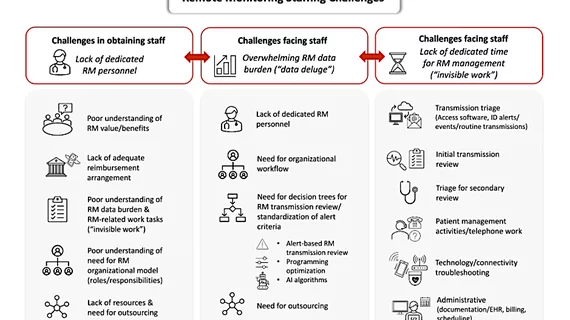Electrophysiology experts issue recommendations for remote monitoring of CIEDs
The Heart Rhythm Society (HRS), European Heart Rhythm Association (EHRA), Asia Pacific Heart Rhythm Society (APHRS), and Latin American Heart Rhythm Society (LAHRS) released a new expert consensus statement on the management of remote device clinics during the Heart Rhythm 2023 meeting over the weekend.
The 2023 HRS/EHRA/APHRS/LAHRS Expert Consensus Statement on Practical Management of the Remote Device Clinic is a joint effort by the four major cardiac electrophysiology societies. It aims to be a comprehensive resource for cardiac electrophysiology, supportive healthcare nurses and technicians, and administrative professionals involved in the management of remote monitoring (RM) programs for cardiovascular implantable electronic devices (CIEDs) such as pacemakers, implantable defibrillators, and implantable loop recorders.
The HRS estimates that there are about 1.7 million CIEDs implanted worldwide annually. Correspondingly, there has been a substantial rise in the number of these patients being remotely monitored. This increase may be attributed to a variety of factors, including the endorsement of remote monitoring as the standard of care for these patients and the increased use of RM during the COVID-19 pandemic.
"For this document, we took a team-based approach to RM including clinical and nonclinical personnel to perform all tasks related to RM," co-chair of the consensus statement Aileen Ferrick, RN, PhD, ACNP, FHRS from the White Plains Hospital said in a statement from HRS. "We delve into topics such as staffing, workflow development, patient education, and communication of transmission results; providing valuable insights that healthcare professionals can use to enhance their practice in caring for patients on RM."
The consensus statement underscores the importance of having adequate and dedicated staffing, ensuring comprehensive patient education, establishing reliable and continuous connectivity, appropriate programming of alerts, and fostering collaborative partnerships among patients, providers, manufacturers and payers. It also highlights the variability in the uptake of RM worldwide and discusses the barriers that lead to this disparity.
"Although the concept and importance of RM is widely appreciated, the application of RM is quite complex. With this document, our aim is to not only address the present-day challenges but also to forecast the trajectory of the field over the next few years," said co-chair of the consensus statement Satish Raj, MD, MSCI, FHRS, with the University of Calgary. "By shedding light on this future path, we strived to provide guidance for a system that works better for providers and, most importantly, works better for patients."
The HRS also said patient partners were involved in the document's development to ensure recommendations centered on delivering optimal patient care that is in alignment with patients’ wants, needs and preferences.
The HRS-led consensus statement was developed in partnership with and endorsed by EHRA, APHRS, and LAHRS. It was created in collaboration with and endorsed by the American College of Cardiology (ACC), American Heart Association (AHA), International Society for Holter and Noninvasive Electrocardiology, and the Pediatric and Congenital Electrophysiology Society (PACES).
Key take-home messages from the HRS remote monitoring expert consensus
The following outline was included at the beginning of the document:
1. For patients with cardiovascular implantable electronic devices, remote monitoring is the standard of care.
2. Prompt patient enrollment and maintenance of regular connectivity with long-term adherence to RM accomplished by individualized patient and caregiver education is essential to an effective RM program.
3. Adequate staffing using both clinical and nonclinical personnel with appropriate patient-to-staff ratios and dedicated time to perform defined roles and responsibilities are essential for managing RM clinic workflows.
4. Clinical staff in the RM clinic should be appropriately educated and/or certified and participate in ongoing quality assurance and improvement programs.
5. Programming alerts specific to device type and indication with established mechanisms for promptly dealing with high-priority alerts can moderate increasing data volume and workload for RM programs.
6. Communicating RM device results with patients, their health care providers, and the patient electronic medical record in a secure and confidential manner should be accomplished according to individual device clinic workflows.
7. A relationship between RM clinics and device manufacturers for bidirectional exchange of ideas for staff training, patient education, patient care services, and management of safety advisories and recalls is imperative.
8. Use of third-party resources may offer financial and practical benefits for dealing with increased device clinic volume.
9. Pediatric patients with CIEDs on RM require scheduling similar to that for RM of adult patients but may have special needs requiring additional considerations.
10. Implantable loop recorders require immediate connectivity to RM with special programming needs based on the patient’s clinical indication for the implantable loop recorder.
11. Alert-based RM that relies on continuous connectivity allows for extended time intervals between in-office device interrogations.
The consensus statement was jointly published in Heart Rhythm, EP Europace, and the Journal of Arrhythmia.

